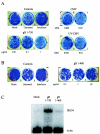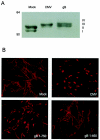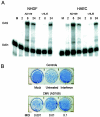Human cytomegalovirus elicits a coordinated cellular antiviral response via envelope glycoprotein B
- PMID: 14722275
- PMCID: PMC321386
- DOI: 10.1128/jvi.78.3.1202-1211.2004
Human cytomegalovirus elicits a coordinated cellular antiviral response via envelope glycoprotein B
Abstract
Previous studies have shown that human cytomegalovirus (CMV) is a potent elicitor of interferon-stimulated gene (ISG) expression. Induction of the interferon pathway does not require replication-competent virus, and envelope glycoprotein B (gB) from CMV is a viral structural component that can directly induce transcription of ISGs. Here we extend these earlier findings by defining the consequences of inducing the interferon pathway. We found that cells respond to CMV or soluble gB by establishing a functional antiviral state within cell types critical in CMV biology, such as fibroblasts and endothelial cells. We have also discovered new insights into the mechanism by which the pathway is initiated. Interferon regulatory factor 3 (IRF3), a key transcriptional regulator of cellular interferon responses, is activated by CMV virions and soluble gB. Thus, IRF3 becomes activated via "outside-in" signal transduction events. This is a novel mechanism of activation of this key transcription factor by viruses. In comparison to soluble gB (gB(1-750)), which comprises the entire ectodomain of gB, a truncation mutant encompassing only the amino-terminal region of gB (gB(1-460)) was markedly less effective at inducing antiviral responses. This indicates that the region of gB from residues 461 to 750 is important for initiation of the antiviral response. In addition, CMV and gB establish an antiviral state in alpha/beta interferon null cells, illustrating that primary induction of ISGs by CMV and gB is sufficient to establish the antiviral response and that interferon secretion is not necessary for the antiviral effect. Taken together, our findings reveal that CMV initiates a coordinated antiviral response through contact between gB and an as-yet-unidentified cell surface receptor(s).
Figures







Similar articles
-
Rhesus cytomegalovirus particles prevent activation of interferon regulatory factor 3.J Virol. 2005 May;79(10):6419-31. doi: 10.1128/JVI.79.10.6419-6431.2005. J Virol. 2005. PMID: 15858025 Free PMC article.
-
Innate cellular response to virus particle entry requires IRF3 but not virus replication.J Virol. 2004 Feb;78(4):1706-17. doi: 10.1128/jvi.78.4.1706-1717.2004. J Virol. 2004. PMID: 14747536 Free PMC article.
-
Activation of the interferon response by human cytomegalovirus occurs via cytoplasmic double-stranded DNA but not glycoprotein B.J Virol. 2010 Sep;84(17):8913-25. doi: 10.1128/JVI.00169-10. Epub 2010 Jun 23. J Virol. 2010. PMID: 20573816 Free PMC article.
-
Interferon-Independent Innate Responses to Cytomegalovirus.Front Immunol. 2019 Dec 11;10:2751. doi: 10.3389/fimmu.2019.02751. eCollection 2019. Front Immunol. 2019. PMID: 31921100 Free PMC article. Review.
-
Virion Glycoprotein-Mediated Immune Evasion by Human Cytomegalovirus: a Sticky Virus Makes a Slick Getaway.Microbiol Mol Biol Rev. 2016 Jun 15;80(3):663-77. doi: 10.1128/MMBR.00018-16. Print 2016 Sep. Microbiol Mol Biol Rev. 2016. PMID: 27307580 Free PMC article. Review.
Cited by
-
Herpes simplex virus glycoprotein B binds to cell surfaces independently of heparan sulfate and blocks virus entry.J Virol. 2005 Sep;79(18):11588-97. doi: 10.1128/JVI.79.18.11588-11597.2005. J Virol. 2005. PMID: 16140736 Free PMC article.
-
Antagonism of host antiviral responses by Kaposi's sarcoma-associated herpesvirus tegument protein ORF45.PLoS One. 2010 May 11;5(5):e10573. doi: 10.1371/journal.pone.0010573. PLoS One. 2010. PMID: 20485504 Free PMC article.
-
Effect of Cytomegalovirus on the Immune System: Implications for Aging and Mental Health.Curr Top Behav Neurosci. 2023;61:181-214. doi: 10.1007/7854_2022_376. Curr Top Behav Neurosci. 2023. PMID: 35871707
-
Polymorphisms in Toll-like receptor genes influence antibody responses to cytomegalovirus glycoprotein B vaccine.BMC Res Notes. 2012 Mar 13;5:140. doi: 10.1186/1756-0500-5-140. BMC Res Notes. 2012. PMID: 22414065 Free PMC article. Clinical Trial.
-
Human cytomegalovirus IE86 attenuates virus- and tumor necrosis factor alpha-induced NFkappaB-dependent gene expression.J Virol. 2006 Nov;80(21):10763-71. doi: 10.1128/JVI.01195-06. J Virol. 2006. PMID: 17041226 Free PMC article.
References
-
- AbuBakar, S., I. Boldogh, and T. Albrecht. 1990. Human cytomegalovirus stimulates arachidonic acid metabolism through pathways that are affected by inhibitors of phospholipase A2 and protein kinase C. Biochem. Biophys. Res. Commun. 166:953-959. - PubMed
-
- AbuBakar, S., I. Boldogh, and T. Albrecht. 1990. Human cytomegalovirus. Stimulation of [3H] release from [3H]-arachidonic acid prelabelled cells. Arch. Virol. 113:255-266. - PubMed
-
- Albrecht, T., I. Boldogh, M. Fons, S. AbuBakar, and C. Z. Deng. 1990. Cell activation signals and the pathogenesis of human cytomegalovirus. Intervirology 31:68-75. - PubMed
-
- Ankel, H., M. R. Capobianchi, C. Castilletti, and F. Dianzani. 1994. Interferon induction by HIV glycoprotein 120: role of the V3 loop. Virology 205:34-43. - PubMed
-
- Ankel, H., M. R. Capobianchi, F. Frezza, C. Castilletti, and F. Dianzani. 1996. Interferon induction by HIV-1-infected cells: a possible role of sulfatides or related glycolipids. Virology 221:113-119. - PubMed
Publication types
MeSH terms
Substances
Grants and funding
LinkOut - more resources
Full Text Sources

